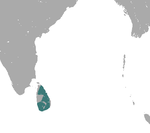Ceylon hat monkey
| Ceylon hat monkey | ||||||||||||
|---|---|---|---|---|---|---|---|---|---|---|---|---|

Ceylon hat monkey ( Macaca sinica ) |
||||||||||||
| Systematics | ||||||||||||
|
||||||||||||
| Scientific name | ||||||||||||
| Macaca sinica | ||||||||||||
| ( Linnaeus , 1771) |
The Ceylon hat monkey ( Macaca sinica ) is a primate species from the genus of macaques within the family of vervet monkeys (Cercopithecidae). He is on Sri Lanka (formerly Ceylon) endemic . Like the closely related Indian hat monkey, it owes its name to the conspicuous crown of hair on its head.
description
With a head body length of around 40 to 55 cm and a maximum weight of only 8.4 kg, the Ceylon hat monkey is the smallest of its kind. Its short fur is gray-brown on the top and whitish on the underside. On the top of his head he has two heads of brown or black hair that are directed outwards and parted in the middle. The bare face is brown in color and the tail is as long or longer than the body.
Way of life
Ceylon hat monkeys are diurnal forest dwellers that inhabit tropical rainforests as well as mountain forests up to an altitude of 2200 m. They spend part of the day on the ground but usually return to the trees to sleep.
They live in groups of around 30 to 40 people, which consist of around twice as many females as males. There is a strict hierarchy within the males, which is expressed in the order in which they search for food and in grooming. While females remain in the group in which they were born, males must leave their group after reaching sexual maturity. Sometimes they join forces with others to form all-male groups. They are territorial animals that often defend their territory of several hundred hectares from other groups.
These primates feed primarily on fruits, seeds, insects, and grasses.
Reproduction
In contrast to other macaque species, there is no normal swelling in hat monkeys, that is, the swelling of the bare buttocks area in females during fertile times. Promiscuity prevails within the group, each male mates with several females and vice versa. A young animal is born after around 160 to 170 days of gestation. The fathers do not take part in raising the young. They are weaned after around a year and the young are sexually mature after 3 to 6 years. The life expectancy of hat monkeys in the wild is around 20 years.
threat
Ceylon hat monkeys have adapted to humans to a certain extent, they sometimes plunder plantations and fields. The main threat is the clearing of forests and the associated loss of habitat. Due to its smaller distribution area, the Ceylon hat monkey is listed by the IUCN as endangered ( vulnerable ).
literature
- Thomas Geissmann : Comparative Primatology. Springer-Verlag, Berlin et al. 2003, ISBN 3-540-43645-6 .
- Don E. Wilson, DeeAnn M. Reeder (Eds.): Mammal Species of the World. A taxonomic and geographic Reference. Johns Hopkins University Press, Baltimore MD 2005, ISBN 0-8018-8221-4 .
Web links
- Information on theprimata.com
- Information on primatis.de
- Macaca sinica in the endangered Red List species the IUCN 2006. Posted by: Eudey et al , 2000. Retrieved on 11 May, 2006.
